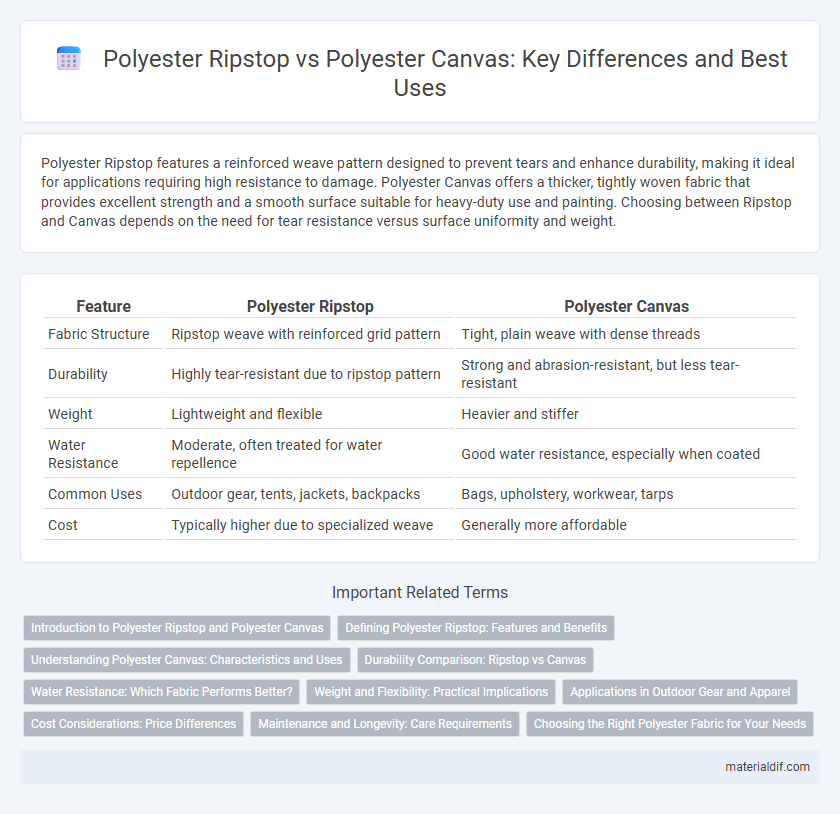Polyester Ripstop features a reinforced weave pattern designed to prevent tears and enhance durability, making it ideal for applications requiring high resistance to damage. Polyester Canvas offers a thicker, tightly woven fabric that provides excellent strength and a smooth surface suitable for heavy-duty use and painting. Choosing between Ripstop and Canvas depends on the need for tear resistance versus surface uniformity and weight.
Table of Comparison
| Feature | Polyester Ripstop | Polyester Canvas |
|---|---|---|
| Fabric Structure | Ripstop weave with reinforced grid pattern | Tight, plain weave with dense threads |
| Durability | Highly tear-resistant due to ripstop pattern | Strong and abrasion-resistant, but less tear-resistant |
| Weight | Lightweight and flexible | Heavier and stiffer |
| Water Resistance | Moderate, often treated for water repellence | Good water resistance, especially when coated |
| Common Uses | Outdoor gear, tents, jackets, backpacks | Bags, upholstery, workwear, tarps |
| Cost | Typically higher due to specialized weave | Generally more affordable |
Introduction to Polyester Ripstop and Polyester Canvas
Polyester ripstop features a unique reinforcing weave pattern that prevents tearing and enhances durability, making it ideal for outdoor gear and lightweight applications. Polyester canvas is a densely woven fabric noted for its strength and water resistance, commonly used in heavy-duty items like tents, bags, and upholstery. Both fabrics utilize polyester's inherent resilience and moisture-wicking properties but differ in texture, weight, and intended endurance.
Defining Polyester Ripstop: Features and Benefits
Polyester ripstop features a distinctive grid pattern of reinforced threads that prevents tears from spreading, offering superior durability compared to standard polyester fabrics. This lightweight material maintains excellent tensile strength and resistance to abrasion, making it ideal for outdoor gear and tactical applications. Its water-resistant properties and quick-drying capabilities enhance performance in harsh weather conditions, providing reliable protection and longevity.
Understanding Polyester Canvas: Characteristics and Uses
Polyester canvas is a durable fabric known for its tight weave, heavyweight feel, and excellent resistance to tearing and environmental elements, making it ideal for outdoor applications such as tents, tarps, and awnings. Unlike polyester ripstop, which incorporates a reinforcing grid to prevent fabric tears, polyester canvas relies on its dense weave and weight for strength and durability. Its water-resistant and mildew-resistant properties, combined with easy maintenance, contribute to its popularity in both industrial and recreational uses.
Durability Comparison: Ripstop vs Canvas
Polyester Ripstop features a reinforced grid pattern that significantly enhances tear resistance, making it ideal for applications requiring high durability under stress, such as outdoor gear and tents. Polyester Canvas, with its tight, plain weave, offers robust abrasion resistance and durability suitable for heavy-duty uses like bags and upholstery. While Ripstop excels in preventing tear propagation, Canvas provides a denser, more durable surface capable of withstanding prolonged wear and rough handling.
Water Resistance: Which Fabric Performs Better?
Polyester ripstop exhibits superior water resistance due to its tighter weave and often includes a durable water-repellent (DWR) coating, making it ideal for outdoor gear exposed to rain and moisture. In contrast, polyester canvas has a thicker, heavier construction but typically lacks the advanced water-resistant treatments, resulting in lower performance against water penetration. For applications requiring enhanced water resistance, polyester ripstop is generally the better choice because of its engineered fabric structure and finish technologies.
Weight and Flexibility: Practical Implications
Polyester ripstop fabric typically weighs less and offers greater flexibility compared to polyester canvas, making it ideal for lightweight outdoor gear that requires durability and ease of movement. Polyester canvas, heavier and stiffer, provides enhanced abrasion resistance and structural support suited for heavy-duty applications like backpacks and tents. The choice between these materials affects comfort, portability, and longevity based on the specific demands of the activity or product design.
Applications in Outdoor Gear and Apparel
Polyester Ripstop features a unique crosshatch weave pattern that provides enhanced tear resistance, making it ideal for durable outdoor gear such as tents, backpacks, and jackets requiring lightweight strength. Polyester Canvas offers a heavier, denser weave that excels in applications demanding abrasion resistance and sturdiness, like hiking boots, heavy-duty backpacks, and protective outerwear. Both materials offer water resistance and UV protection, but Polyester Ripstop prioritizes flexibility and weight, while Polyester Canvas emphasizes toughness and longevity.
Cost Considerations: Price Differences
Polyester ripstop generally costs more than polyester canvas due to its specialized woven pattern designed to prevent tearing, enhancing durability for demanding applications. Polyester canvas, while less expensive, offers a sturdy and breathable option suited for budget-conscious projects requiring moderate strength. Choosing between these fabrics depends on balancing price against performance needs, with ripstop favored in high-stress environments and canvas preferred for economical everyday use.
Maintenance and Longevity: Care Requirements
Polyester Ripstop requires minimal maintenance due to its lightweight weave and resistance to tearing, making it ideal for frequent outdoor use. Polyester Canvas, with its thicker and denser construction, demands more thorough cleaning to prevent dirt buildup but offers exceptional durability over time. Both materials benefit from regular cleaning with mild soap and cold water, while avoiding harsh chemicals extends their longevity.
Choosing the Right Polyester Fabric for Your Needs
Polyester Ripstop features a grid pattern that prevents tearing, making it ideal for lightweight, durable applications like outdoor gear and backpacks, while Polyester Canvas offers a thicker, more robust weave suited for heavy-duty uses such as tote bags and upholstery. Selecting the right polyester fabric depends on balancing durability requirements and weight preferences; Ripstop excels in tear resistance with minimal weight, whereas Canvas provides superior strength with added rigidity. Consider environmental exposure and usage frequency to determine whether the flexible, abrasion-resistant Ripstop or the sturdy, heavier Canvas aligns best with your project needs.
Polyester Ripstop vs Polyester Canvas Infographic

 materialdif.com
materialdif.com